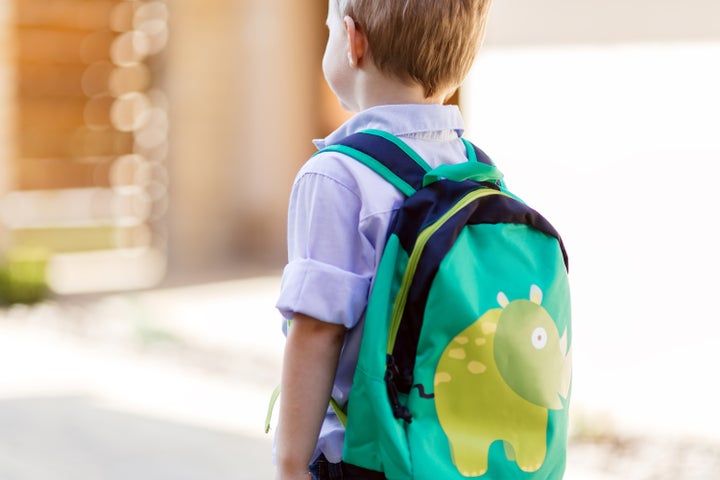
Minimally Invasive Spine Surgeon
Mount Sinai Spine Hospital
Assistant Professor of Orthopedic Surgery
Icahn School of Medicine at Mount Sinai
We have all seen a tiny kid carrying an enormous, overstuffed backpack. It might look cute, but a child whose backpack is too heavy may suffer back, shoulder, or neck pain. And evidence suggests that people who experience frequent back pain in childhood tend to have more back pain and other musculoskeletal issues in adulthood.
If children feel fine during summer vacation or other breaks, but start complaining of pain in the back, shoulders, or neck once school is back in session, an overloaded backpack may be to blame. Carrying excess weight can strain the muscles, causing pain and joint overuse. Parents can help their kids avoid such injury by making sure the filled backpack is not too heavy, and then lightening the load if it is.
Simply weigh your child’s backpack, with typical contents inside, to determine how heavy it is. As a rule, it should weigh no more than 10 percent to 15 percent of your child’s body weight (closer to 10 percent is preferable). For example, if your child weighs 50 pounds, he or she should carry a pack no heavier than 5-7 pounds.
In addition to weighing the full pack, observe how your child walks with it on. If he or she is constantly hunching forward, bending backward, or leaning to one side or the other, the pack may be overstuffed.
Another factor to consider is how your child commutes to school—walking, sitting in a car, taking a bus—and how long any wait time is. Walking or waiting with a heavy backpack for 20 minutes a day is more problematic than briefly carrying it to your car for the ride to school.
How to Choose the Right Backpack
It is important for parents to help choose the backpack. Just as not every shoe is made for every foot, not every backpack will fit every child. Kids should try out a backpack in the store by putting it on and walking around. It should fit their body size and shape well, hugging the contours of their back with maximum surface area contact.
Here are a few other features to look for in a pack:
· Lightweight material, such as nylon instead of leather;
· Padded double straps, to distribute the weight evenly across the shoulders (avoid one-strap, cross-body packs);
· A belt that connects the two straps, or a waist belt, to transfer the load more evenly throughout the back and pelvic region.
If your child has a growth spurt, reassess the bag to make sure it still fits and is not too short or small. For some kids, especially older ones who have to lug heavy books, a rolling backpack may be more appropriate.
Using a Backpack Properly
Choosing the best backpack will go only so far in preventing injury and pain; kids also need to use it correctly:
· Keep the load as light as you can. When possible, using two sets of books—one to keep at home and the other at school—may help allay some weight issues.
· Always use both shoulder straps. They should be tightened symmetrically; not one loose and the other taut.
· Position the pack properly. Make sure the straps fit the shoulders and chest snugly so that the bag can hug the back and not sag too low.
Some straps may loosen over time. When you first fit them, indicate with a permanent marker where the straps should be and then check them every couple of weeks to see if they need to be readjusted.
When to Call a Doctor
A day or two’s worth of pain related to muscle strain or joint overuse due to carrying too much weight is probably harmless. The pain can usually be treated with rest, heat, and over-the-counter anti-inflammatory medications as needed, followed by carrying a lighter load in the future.
If a child still complains of significant, ongoing back pain, it is important not to ignore it. Prior to adolescence, children do not typically have persistent back pain. This could indicate a more serious, underlying condition, particularly if it worsens at night or is accompanied by fever, leg pain, refusal to walk, a limp, unintentional weight loss, a recent trauma, infection, or bowel or bladder issues. In these cases, it is important to consult with your child’s pediatrician immediately, who will likely refer your child to a pediatric orthopedist or pediatric spine specialist.
Following Up
I encourage parents to be actively involved in their child’s mental and physical health. This includes having a brief conversation every few months about any issues they may be having with their backpacks. Ask if it feels too heavy or if they are feeling any back, neck or shoulder pain. As the school year goes on, and notebooks and papers start filling the pack, take notice of its weight, the strap situation, and how your child is walking so that you can address any problems. Make this part of your routine, and you will help children avoid aches and pains now and maintain healthy backs into adulthood.